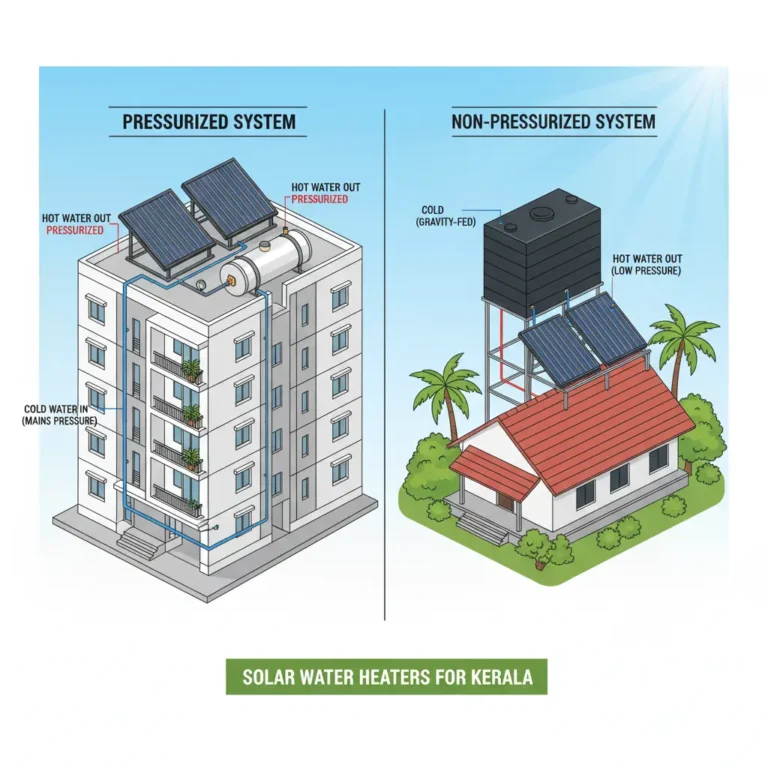What is Pressurized Solar Water Heater
A pressurized solar water heater is a form of solar water heating system that stores and provides hot water under pressure, with a direct connection to the building’s main water supply. A pressurized solar water heater is ideal when you need dependable, high-pressure hot water for residential or commercial properties with multiple taps or showers operating simultaneously.
Key Features of Pressurized Solar Water Heater
- Pressurized Storage Tank:
- The system uses a pressure-rated tank to store hot water.
- It can withstand the pressure of multiple outlets or taps.
- High Water Pressure:
- Provides consistent water pressure, suitable for showers, faucets, and multi-storey buildings.
- Integration with Main Supply:
- It can be connected directly to the municipal water line or a pump system.
- Solar Collector:
- Uses solar panels or evacuated tube collectors to absorb sunlight and heat the water.
- Uses solar panels or evacuated tube collectors to absorb sunlight and heat the water.
- Backup Heating (Optional):
- Many pressurized systems include an electric or gas backup heater to ensure hot water even on cloudy days.

Advantages of Pressurized Solar Water Heater
- High Water Pressure: Provides hot water at a steady pressure that can be used for taps, showers, and multiple outlets simultaneously.
- Suitable for Multi-Storey Buildings: Installable in large residences, hotels, and flats, in contrast to gravity-based non-pressurized systems.
- Direct Connection to Main Water Supply: Works directly with municipal or pump-fed water supplies, eliminating the need for elevated tanks.
- Supports Multiple Outlets: Can provide hot water to multiple taps or showers at the same time, making it perfect for large families.
- Backup Heating Option: Many systems have electric or gas backup heaters to ensure hot water even on gloomy days.
- Efficient and Reliable: Stores hot water under pressure, delivering ready-to-use hot water anytime needed.
- Better for Modern Plumbing: Compatible with high-pressure plumbing fittings and modern bathroom designs.
- Durable Construction: Tanks and pipes are designed to bear pressure, which increases longevity and safety.
Disadvantages of Pressurized Solar Water Heater
- Higher Cost: More costly than non-pressurized systems because of pressure-rated tanks, pumps, and fittings.
- Complex Installation: Demands expert installation and accurate plumbing to deal with high pressure effectively.
- Maintenance Requirements: Periodic maintenance is required for pressure valves, pumps, and storage tanks to guarantee safety and efficiency.
- Risk of Pressure-Related Issues: Without suitable safety mechanisms (such as pressure release valves), there is a risk of leaks and tank damage.
- Energy Use for Backup (Optional): Backup heaters (electric or gas) may require additional energy, resulting in a slightly higher operating cost.
- Not Ideal for Low Water Demand: Too much for single-bathroom or small-home settings, where a non-pressurized system is more affordable and adequate.
What is Non-Pressurized Solar Water Heaters
A non-pressurized solar water heater (also known as an open-vented solar water heater) is a system that stores hot water in a tank that is exposed to the atmosphere. Water flows to taps and outputs by gravity rather than pressure. A Non-Pressurized Solar Water Heater is easy to use, secure, and affordable, perfect for single-storey homes or low-demand households, but it won’t offer high water pressure for multi-storey buildings.
Key Features of Non-Pressurized Solar Water Heaters
- Gravity-Fed System
- Water pressure depends on the height difference between the storage tank and the tap.
- Usually, the tank is installed above the outlets.
- Simple Design
- Fewer components than pressurized systems — typically a solar collector, storage tank, and connecting pipes.
- Fewer components than pressurized systems — typically a solar collector, storage tank, and connecting pipes.
- Safe Operation
- Open vent prevents pressure buildup, reducing the risk of leaks or bursts.
- Open vent prevents pressure buildup, reducing the risk of leaks or bursts.
- Solar Collector
- Uses flat plate or evacuated tube collectors to heat water.
- Uses flat plate or evacuated tube collectors to heat water.
- Auxiliary Heating (Optional)
- It can include an electric or gas backup heater for cloudy days.
Advantages of Non-Pressurized Solar Water Heaters
- Low Cost: The simple design and fewer components make it less expensive than pressurized systems.
- Safe to Use: An open-vented tank lowers the chance of leaks, ruptures, or mishaps by preventing pressure buildup.
- Easy Installation: Minimal plumbing requirements make it perfect for compact spaces or single-story dwellings.
- Low Maintenance: With fewer parts and no high-pressure tank, there is less maintenance and a longer life.
- Eco-Friendly & Efficient: Uses solar energy directly, saving electricity and lowering energy expenditures.
- Ideal for Small Homes: Ideal for low-water-demanding single-story homes.
- Durable: Open design and simple components save wear and tear when compared to pressurized systems.
Disadvantages of Non-Pressurized Solar Water Heaters
- Low Water Pressure: Since water flows by gravity, there is little pressure, making it unsuitable for showers or running several taps at once.
- Not Suitable for Multi-Storey Buildings: The storage tank must be located above the outlets, which makes it problematic for apartments or tall structures.
- Limited Flow Rate: Can only provide modest amounts of water at once, which makes it less suitable for homes with large water demands.
- Dependent on Tank Height: The water flow is solely dependent on the height difference between the tank and the tap.
- Backup Heating May Be Needed: On overcast or rainy days, an electric or gas backup may be required to supply hot water demand.
Difference Between Pressurized Solar Water Heaters & Non-Pressurized Solar Water Heaters
Pressurized Solar Water Heaters
- Key Features:
- Can supply water at high pressure, suitable for multiple taps, showers, or floors.
- Usually equipped with a pump or a pressure-rated storage tank.
- Can work with multi-storey buildings.
- Pros:
- Suitable for high-rise buildings and areas with high water demand.
- Can deliver hot water at consistent pressure to multiple points.
- Works even in low sunlight if combined with an auxiliary heater.
- Cons:
- More expensive than non-pressurized systems.
- Requires robust installation and sometimes maintenance.
- Ideal For:
- Apartments, hotels, and homes with multiple bathrooms.
Non-Pressurized Solar Water Heaters
- Key Features:
- Water is supplied by gravity, not pressurized.
- The tank is usually installed higher than the outlet points.
- Best for single-storey homes or low-rise buildings.
- Pros:
- Simple design and low cost.
- Requires less maintenance.
- Safe from pressure-related accidents.
- Cons:
- Cannot supply water to high-rise buildings efficiently.
- Water pressure depends on the height difference between the tank and the tap.
- Limited flow if multiple outlets are used simultaneously.
- Ideal For:
- Bungalows, small homes, and single-storey buildings.
Conclusion
Choosing the proper solar water heater is determined by your household’s water requirements, building type, and budget. Pressurized systems are great for multi-storey buildings and high-demand houses, as they provide regular water pressure and dependability. Non-pressurized systems, on the other hand, are less expensive, safer, and ideal for single-storey homes with moderate hot water needs.
As the best solar company in Kerala, Neal Solar provides quality pressurized and non-pressurized solar water heaters that are customized to your unique requirements. Our experienced team guarantees effective installation, peak performance, and sustained solar energy savings. Make the move to solar power today to take advantage of dependable, environmentally friendly, and sustainable hot water solutions.
